Our first planned activation for Sunday 11th June 2017 was the Lower Glenelg River Conservation Park 5CP-122 & VKFF-0905. The park is located about 31 km south east of Mount Gambier, and about 465 km south east of Adelaide, in the south east corner of South Australia.
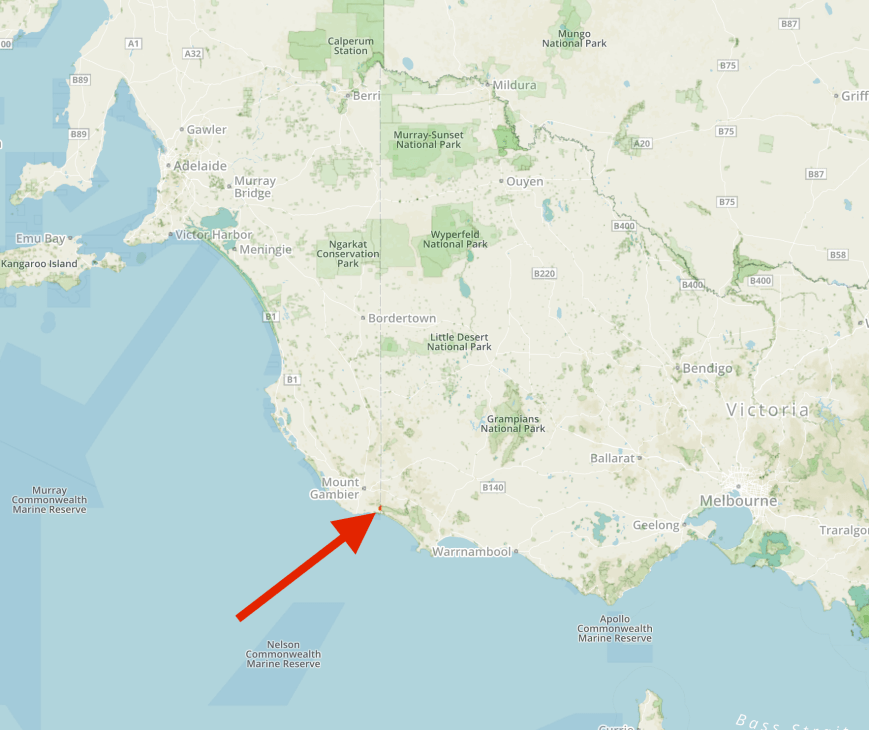
Map showing the location of the Lower Glenelg River Conservation Park. Map courtesy of Protected Planet.
The park is located right on the South Australian/Victorian State border. Access to the park from the South Australian side can only be made via boat. Or you can access the park via a a 4WD track from the Victorian side which is what Marija and I did.
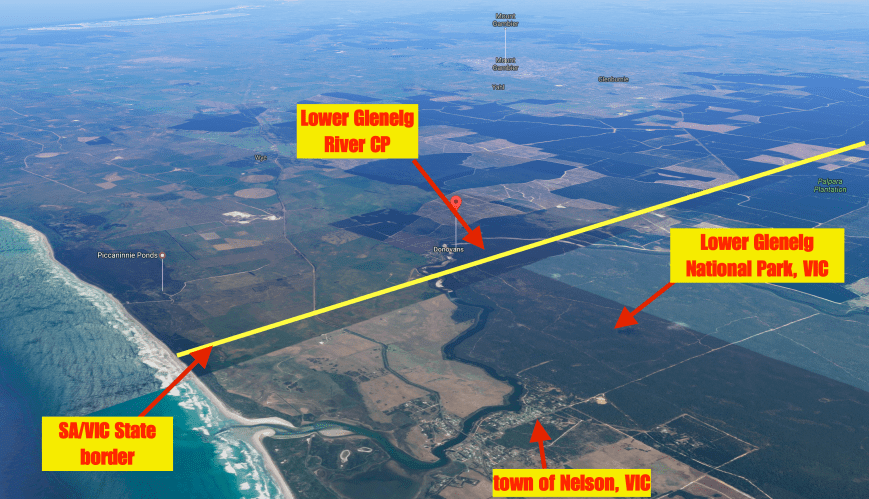
Aerial shot showing the Lower Glenelg River Conservation Park on the SA/VIC border, and the adjacent Lower Glenelg National Park in Victoria. Image courtesy of Google maps.
The map below shows our route. We travelled south east out of Mount Gambier down towards the South Australian/Victorian border. It was a cold morning with quite a bit of drizzle. It wasn’t looking good for the activation.
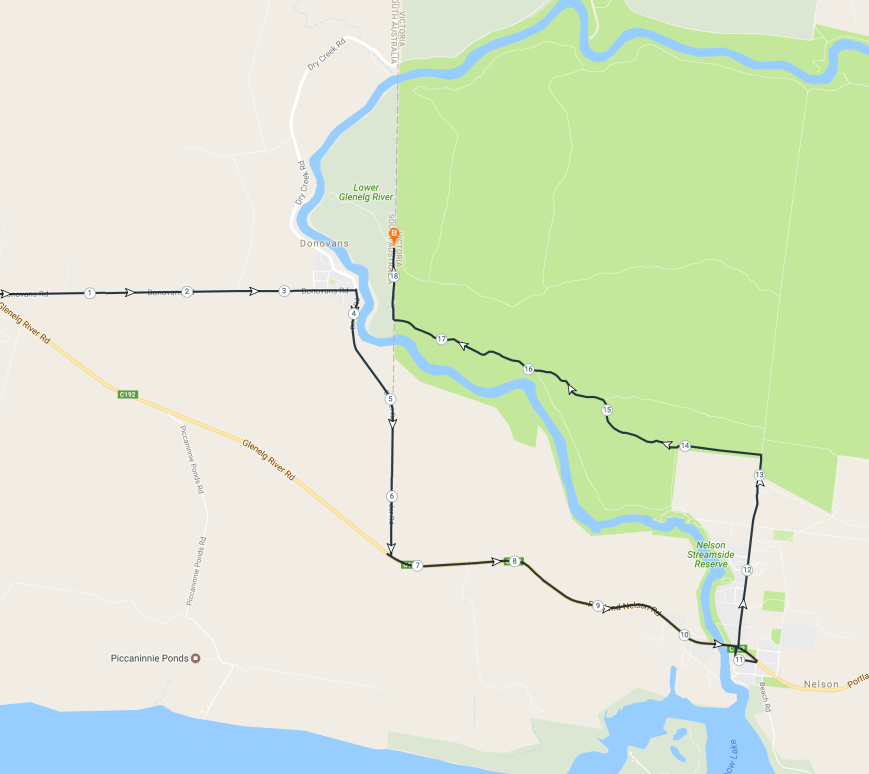
Our route to the park. Map courtesy of plotaroute.com
Marija and I made a quick detour off the Glenelg River Road, down Donovans Road, into the little town of Donovans which is situated on the banks of the beautiful Glenelg River. The area was originally known as Donovans Landing, and was owned by, and named after Thomas John Donovan. He was famous due to him shooting the Tantanoola Tiger, a ‘phantom cat’, which is now preserved in the Tantanoola Hotel.
In 1884 a Bengal Tiger is purported to have escaped from a travelling circus in the South East. A search was mounted, however the tiger was never located. There were however, over the next few years, numerous reports of missing sheep in the area, with many suggesting that the tiger was responsible. Eleven years later, Donovan saw what he thought was the tiger in a paddock, with a sheep in its jaws. Donovan subsequently shot and killed the animal which turned out to be a Eurasian Wolf. It is believed that the wolf was a stowaway on board a boat shipwrecked off the coast and somehow made it to shore. A very interesting tale indeed.
There are some nice views here to be had of the Glenelg River. The river rises in the Grampian Ranges in western Victoria and flows generally north, then west, then south, for over 350 km. This makes it the longest river in south west Victoria and the third longest river overall. A short stretch of the lower end of the river winds through South Eastern South Australia before returning to Victoria to enter Discovery Bay at Nelson.
The river was named after Colonial Secretary Baron Glenelg, Charles Grant (1778-1866), by Major Thomas Mitchell in August 1836. Grant was a Scottish politician and colonial administrator.

Charles Grant, 1st Baron Glenelg
From Donovans we made the short trip to the South Australian/Victorian State border. There is an information board here marking the survey of the border. The boundary between South Australia and Victoria, formerly the Port Phillip District of New South Wales, was marked from the shores of the Southern Ocean to the south bank of the River Murray between 1847 and 1850.
There was also a sign here indicating that we were entering into the Glenelg Shire. A new shire for us to activate for the VK Shires Contest.
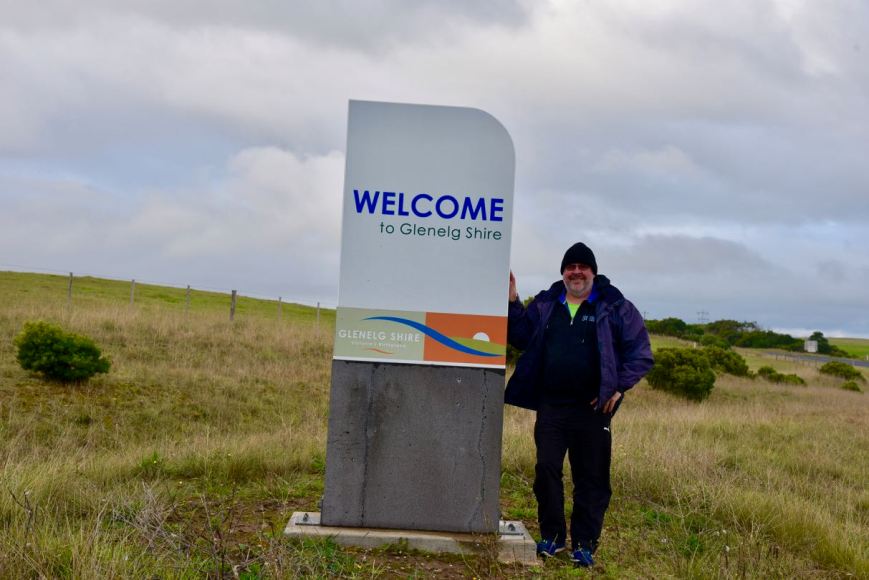
We then drove into the little town of Nelson. This is a small fishing village with a population of around 250 people. It is located at the mouth of the Glenelg River. In January 1852 the name of Nelson was adopted for the settlement, after the ship Lady Nelson, which was used by Lieutenant James Grant in explorations of the area in the early 1800’s.
We drove north out of Nelson on the North Nelson Road. We soon reached the junction with Forest Road and the start of the Lower Glenelg National Park. We then turned left onto Moores Track and travelled west through the Lower Glenelg National Park in Victoria.
Just after we turned into Moores Track we could see a tree down across the track ahead of us. Fortunately someone had cut most of it up with a chainsaw, and there was sufficient room for us to pass.

Morres Track was generally in good condition except for one spot which is shown in the photo below. It didn’t look much, but the puddle was about 1.5 feet deep and very boggy, but we made it through in the Toyoa Hi Lux without any issues.

For the remainder of the trip along Moores Track it was clear driving, but slow. The park was absolutely alive with kangaroos who often darted out in front of us.
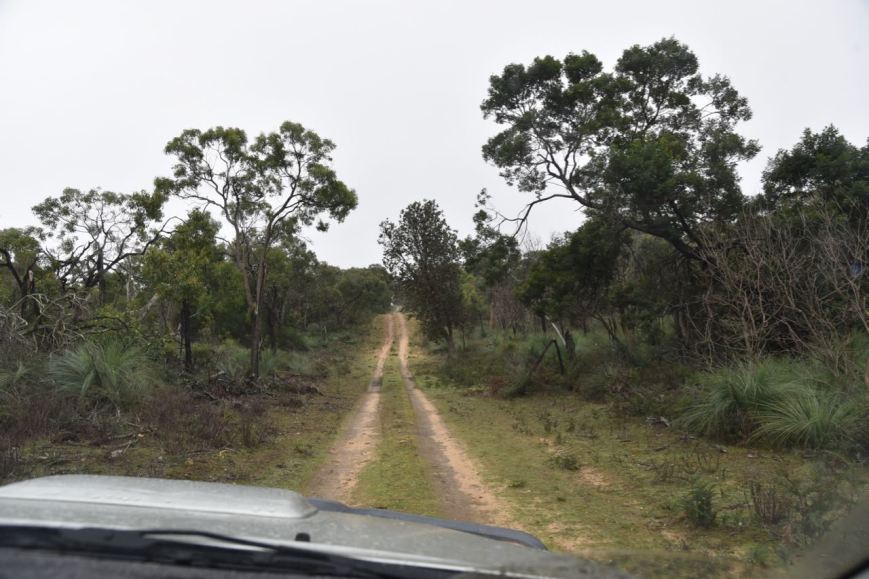
When we reached the right hand turn dog leg on Moores Track, we had reached the State border.
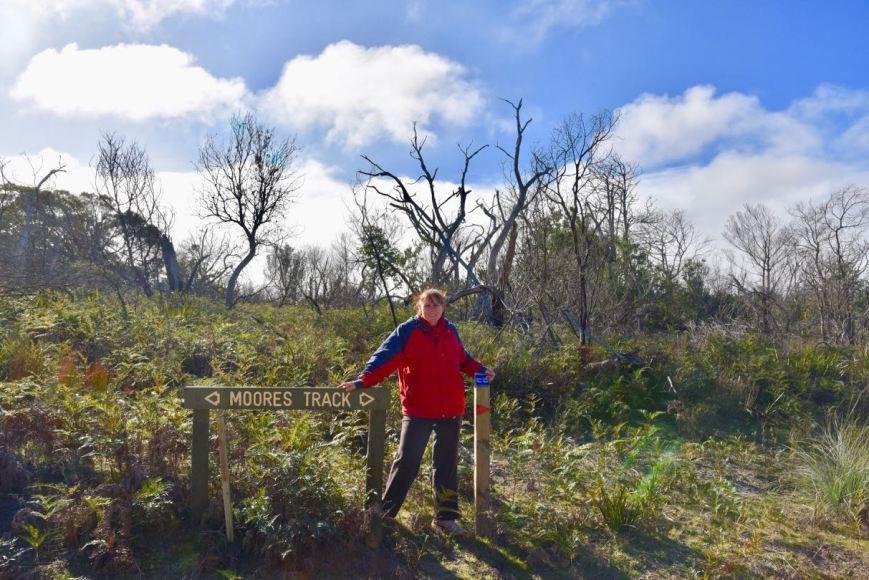
Marija at the dog leg and the State border
We travelled a little further up Moores Track until we reached the junction with McHughs Track. There was a Lower Glenelg River Conservation Park sign here.
We decided to travel west down McHughs Track to see if it would take us down to the river. It was slow going as it was quite overgrown. Take note, there are no turn around areas, or places to pull off, until you get to the very end of the track.
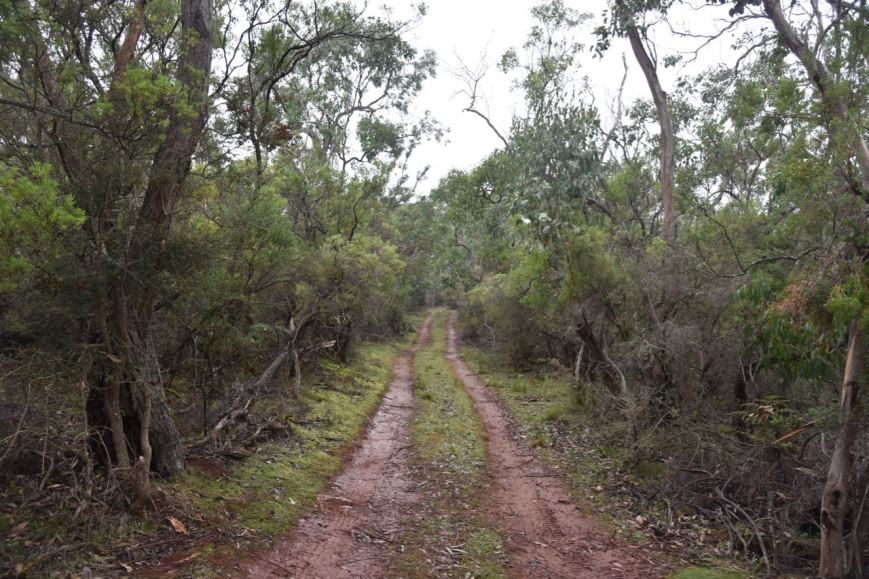
Unfortunately there were no places to set up once we got to the end of the track, as the scrub is just too thick. However, it was worth the drive down, as we were rewarded with some nice views of the Glenelg River, despite the fog.
We returned to the junction of Moores Track and McHughs Track and set up. As it was still drizzling with rain, Marija and I set up underneath the annexe of the Toyota Hi Lux. We ran the Yaesu FT-857d for this activation, along with the 80/40/20m linked dipole.
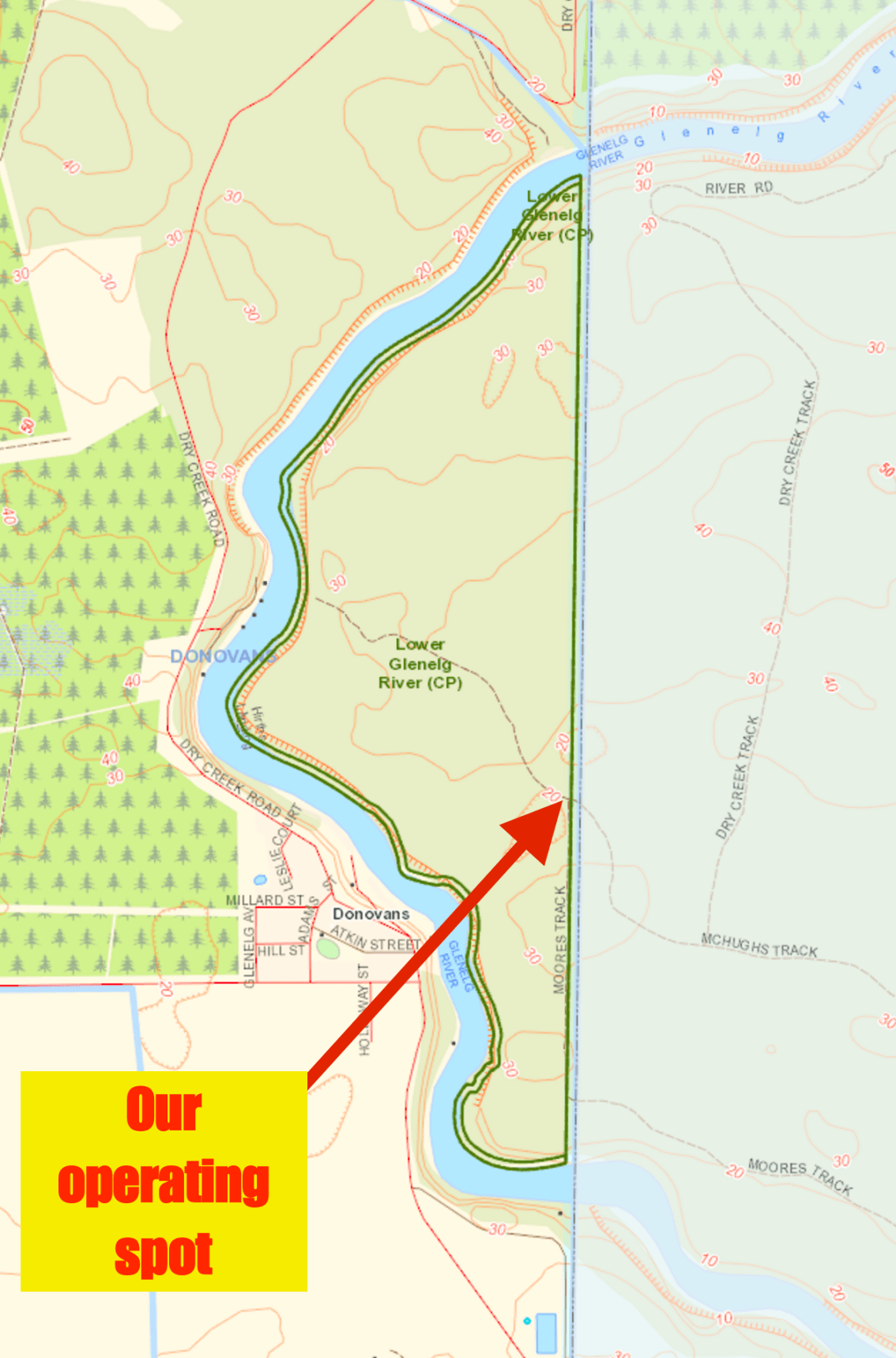
Map of the park showing our operating spot. Map courtesy of Location SA Viewer.
The Lower Glenelg Conservation Park is 127 hectares in size, and was dedicated in 1993 for the conservation of important vegetation associations and species. It is an extension of Victoria’s Lower Glenelg National Park, which adjoins it on the eastern boundary. The Glenelg River forms the western boundary of the park. The Park contains an endangered vegetation association (Swamp Gum woodland) and several endangered plant species. Two of the endangered species include the Slender Greenhood and Shining Buttercup.
The Great South West Walk (250 kilometres of walking trail) passes through the Lower Glenelg River Conservation Park.
The Park provides habitat for a variety of threatened fauna species including the Rufous Bristlebird, Yellow-tailed Black Cockatoo, Peregrine Falcon, Azure Kingfisher, Heath Mouse, and Red-necked Wallaby.
This was to be a unique park for both Marija and I, for both the World Wide Flora Fauna (WWFF) program and the VK5 National & Conservation Parks Award. Marija kicked off the activation, calling CQ on 7.144. It was a slow start, with around 3 minutes of calls going unanswered. I had spotty phone coverage but was eventually able to spot Marija, with her first caller following very soon after. Peter VK3PTE was first in the log, followed by Glen VK2VVV, and then Rick VK4RF/VK4HA.
The WIA broadcast kicked off soon after on 7.146, so we QSY’d down the band to 7.095. Marija soon had 10 contacts in the log, qualifying the park for her for VKFF. After logging 12 contacts, Marija was happy to hand the mic to me. Included in her 12 contacts was a Park to Park QSO with Tony VK3XV/p who was activating the Barmah National Park VKFF-0739.
I then jumped on the mic and called CQ on 7.095. My CQ call was answered by Peter VK3PF, followed by Geoff VK3SQ, Greg VK2EXA, and then Adrian VK5FANA. Within 10 minutes I had contact number 10, with VK4AAC/2, in the log, and the park qualified for VKFF. I logged 21 stations on 40m from VK1, VK2, VK3, VK4, and VK5, before heading over to 3.610 on the 80m band.
I there logged John VK5BJE from the Adelaide Hills with a good 5/5 signal. Sadly, John was my only contact on 80m. I then QSYd back to 7.095 hoping to pick up a few more contacts on my quest to 44 contacts to qualify the park for WWFF. Within another 40 minutes, I had contact number 44 in the log. It was Graham VK7ZGK with a thumping 5/9 plus signal from Tasmania.
All up I made a total of 51 contacts on 40m and 80m, with a number of contacts made for the VK Shires Contest. I had one Park to Park contact, that being with Tony VK3XV/p in the Barmah National Park VKFF-0739.
Marija worked the following stations on 40m SSB:-
- VK3PTE
- VK2VVV
- VK4RF
- VK4HA
- VK2AB
- VK4AAC/2
- VK5KLV
- VK4RF (after the UTC rollover)
- VK4HA (after the UTC rollover)
- VK1AT
- VK2VW
- VK3SQ
- VK3WMM/p
- VK3XV/p (Barmah National ParkVKFF-0739)
I worked the following stations on 40m SSB:-
- VK3PF
- VK3SQ
- VK2EXA
- VK5FANA
- VK2AB
- VK4RF
- VK4HA
- VK3HBG
- VK4TAA
- VK4AAC/2
- VK2EMI
- VK1MA
- VK1AT
- VK5KLV
- VK2KYO
- VK2OA
- VK5LOL
- VK1HW
- VK2NP
- VK3MCK
- VK5HSX/2
- VK2ESG
- VK3LM
- VK5MBD
- VK3KAI
- VK3GV
- VK4TJ
- VK4/AC8WN
- VK4/VE6XT
- VK2HHA
- VK7JGD
- VK5NJ
- VK3CM
- VK3MRG/p
- VK2TCL
- VK3XV/p (Barmah National Park VKFF-0739)
- VK5MA/p
- VK2XXM
- VK7EE
- VK2UH
- VK5PL
- VK5BJE
- VK7ZGK
- VK6MN
- VK5DT
- VK3CBP
- VK7PAL
- VK3ZLD
- VK3BBB
- VK3MAB
I worked the following station on 80m SSB:-
- VK5BJE
References.
Government of South Australia, 2000, Lower Glenelg River Conservation Park Management Plan.
State Library South Australia, 2017, <http://www.samemory.sa.gov.au/site/page.cfm?u=276>, viewed 14th June 2017
Wikipedia, 2017, <https://en.wikipedia.org/wiki/Glenelg_River_(Victoria)>, viewed 14th June 2017
Wikipedia, 2017, <https://en.wikipedia.org/wiki/Charles_Grant,_1st_Baron_Glenelg>, viewed 14th June 2017
Wikipedia, 2017, <https://en.wikipedia.org/wiki/Nelson,_Victoria>, viewed 14th June 2017




























Hi Paul
I am glad to be a unique! I certainly publicised that you were on 80m as well.
I enjoyed the description of the Park and activation.
Cheers
John D
VK5BJE/VK5PF
Hi John,
Marija and I would like to come back here and do a cruise down the Lower Glenelg. It certainly is a very picturesque spot.
Thanks for the posts. It’s sad that more VK5’s didn’t call in on 80m.
73,
Paul VK5PAS